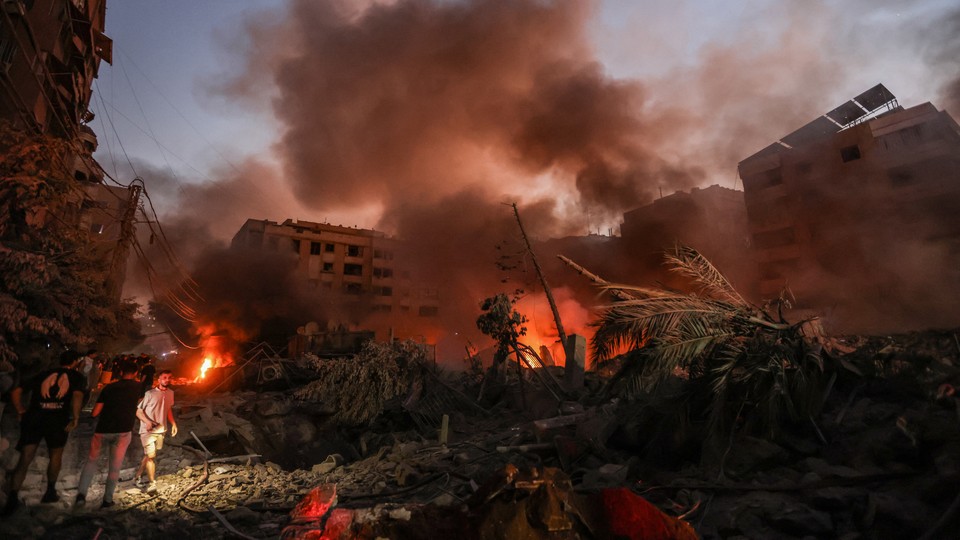Nasrallah’s Folly
3 min read
Israel said on Friday afternoon that it had carried out an air strike on the “central headquarters” of Hezbollah in the southern suburbs of Beirut. Hezbollah Secretary General Hassan Nasrallah was reportedly the target of the attack; his fate remains unclear.
The strike caps a sequence of Israeli attacks over the past two weeks that have wreaked havoc on Hezbollah as an organization. The pager and walkie-talkie attacks that began on September 17—which former U.S. Secretary of Defense Leon Panetta went so far as to describe as “terrorism”—would have maimed a good portion of Hezbollah’s mid-level leadership, making it very hard for Hezbollah to organize itself coherently in response to the Israeli aerial bombardment, much less prepare for a prospective ground assault into southern Lebanon.
Armies must all be able to shoot, move, and communicate—that’s the blocking and tackling of war. By taking away the ability of Hezbollah operatives to securely communicate with one another at the tactical level, Israel dealt a serious blow to its adversary while no doubt reaping an intelligence bonanza in the process. Never before has Hezbollah’s rank and file been so publicly exposed and, worse, humiliated.
Israel’s relentless air strikes this week, meanwhile, appear to have devastated much of Hezbollah’s senior leadership, not to mention its missile stores. I am often skeptical of Israel’s ability to do serious harm to its non-state adversaries through air strikes alone, but militarily, Hezbollah is surely reeling. As Yezid Sayigh, a senior fellow at the Carnegie Middle East Center in Beirut, observed, Israel’s “ability to deploy superior military firepower and technology” might just render the need for a ground assault somewhat moot.
Israel has tried to chasten and degrade Hezbollah through the air before—in 1993, with the feckless Operation Accountability, and 1996, with the Grapes of Wrath campaign—but it’s clear that much has changed since the 1990s. Much has also changed since the summer of 2006, when Hezbollah managed to embarrass Israel in 34 days of fighting.
In 2016, I asked Herzi Halevi—now the commander of the Israel Defense Forces but then its intelligence chief—what he most feared. His answer was a ground incursion from southern Lebanon into northern Israel, one in which Hezbollah either temporarily seized Israeli territory or kidnapped Israeli civilians and took them as hostages. I have often thought of this when reflecting on Israel’s failure to anticipate and prepare for the attacks on October 7 of last year.
But it’s clear now that Israel was preparing for Hezbollah. This—not a fight against Hamas—was the fight Israel anticipated, and wanted. And it was indeed ready.
The question now, if Nasrallah has been killed, is whether Iran feels that it must directly respond. The Lebanese—not just Hezbollah’s largely Shia Muslim constituents but all Lebanese—will have grimly noted that after Hezbollah sent hundreds of men to fight and die in Iraq and Syria for Iran and the Assad regime, neither Syria nor Iran has lifted a finger to relieve the Israeli pressure on Lebanon. But Iran does not want a war with Israel, and any response it makes will likely be carefully calibrated to avoid one.
Spare a thought for the innocent Lebanese living in the high-rise buildings that collapsed in Israel’s air strike. They didn’t ask for Hezbollah to build its command center underneath their homes following the 2006 war. They didn’t ask for any of this.
Hezbollah, which alone among Lebanon’s militias kept its arms following the conclusion of that country’s civil war, has always claimed that its belligerence is necessary to protect Lebanon. But Hezbollah’s actions since—which have almost always been in the service of its own political needs, or those of its ungrateful Iranian sponsors—have brought nothing but pain for all Lebanese, and particularly for the downtrodden Lebanese it claims to represent.



